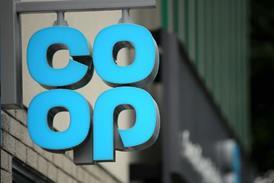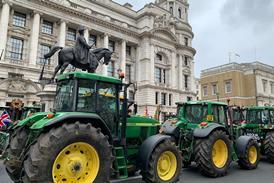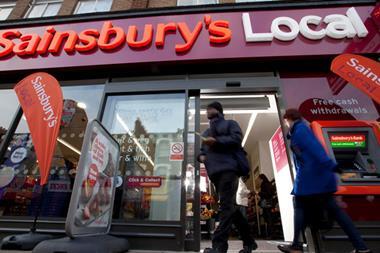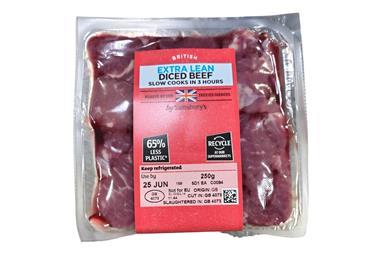The first thing to forget about Ross McLaren is the notion that he is “old school Sainsbury”. He isn’t. Sure, the president and ceo of the multiple’s New England subsidiary Shaw’s has spent the whole of his working life with the chain. But it’s his experience on the other side of the pond that has turned the likeable Scot into the kind of executive which the PR gurus insist is “mid-Atlantic”. Ask McLaren, and he will quickly tell you that he’s a “hybrid, ex-pat Sainsbury man”. Forget the long gone thoroughly English Stamford Street clone in starched white shirt, sober tie and grey suit which was characteristic of Sainsbury in McLaren’s early years. Working under the flag of Uncle Sam has given him the super cool persona that befits a business high flyer from North America’s East Coast. Colleagues say that he’s as much at home in Cape Cod as the 42nd floor of a concrete tower in Manhattan’s financial district. A well cut blazer and slacks, worn with a blue crisp button down collared shirt that even “loaded with bucks” native Bostonians would be proud of, augments the carefully trimmed steel grey locks. So to the 29,000 associates who run Sainsbury’s Massachusettss outpost, he’s as New English as clam chowder. But the soft Scottish accent, flavoured with just a touch of downtown Bostonian, gives away his far off origins. And when you talk to McLaren, or as he’s affectionately better known to UK colleagues, Sainsbury’s “man in the colonies”, you soon realise that beneath that “typically-American” mohaired veneer is a fun-loving Scottish guy with a talent for making retail businesses buzz. At 58, and with retirement on the horizon, he may not have very much longer heading the 185-store chain. But there’s no sign of a diminution of the passion that has driven the operation to such heights and made even the most caustic of London City analysts finally sit up and take notice. McLaren’s working day sees him leave his high rise Boston apartment at 6.30am. A short Buick ride along the freeway takes him to his office on the outskirts of the city by 7.15. “America starts much earlier than Europe,” he points out with a grin. And while his working day can be as intense as his years at Stamford Street, he admits that it is “more relaxed, as that is the American way”. Having said that, he spends several days every week touring stores. That means serious travelling. “We only have 185 branches but they are crammed into the six states of New England which, alone, represent two-thirds of the land mass of Britain. I have to do some pretty nifty driving to get to my northern stores.” So how does he relax? The adopted New England image re-emerges when he reveals that, as “one of the few Scotsmen who does not play golf”, he has a passion for sailing. But McLaren rejects any notion Shaw’s is just a UK chain transplanted into the land of Wal-Mart, Kroger and other razzmatazz-ridden retailing high flyers. Alongside other European firms who have cannily come to dominate grocery retailing down North America’s fashionable east coast, it has a distinctive identity. And that image and all-round offer competes successfully alongside stores owned by Euro giants including Ahold, Delhaize and Tengelmann. But to the many UK retail pundits who sneak unofficial visits en route to other grocery outposts further west, the chain has often been dubbed “more Waitrose than Sainsbury”. And while that may irk the executives who are pioneering Sainsbury’s new quality and value programme back home, it’s clear there are many examples of cross- Atlantic co-operation between parent and US subsidiary. McLaren insists that the sharing of best practice is a dominant feature of the relationship with head office back in London.”We’ve had Sainsbury’s health and beauty manager over here to see our operation recently, and directors Sara Weller and Stuart Mitchell fly across regularly.” Add the fact that the produce group at Sainsbury has adapted Shaw’s module for some of its departments in the UK and you have even more examples of the cross-Atlantic co-operation. But there are many features of grocery retailing New England-style which McLaren claims are hard for his colleagues back home to grasp. For one thing, the states of Connecticut, Maine, Massachusetts, New Hampshire, Rhode Island and Vermont have a very diverse population. He points out that the British consumer is much more homogenous. In his stores, customers can be Portuguese, Chilean or even Cuban and Russian, and they all have their own demands when it comes to taste and cuisine. But then a pragmatic approach to retailing comes naturally to McLaren. He joined JS in 1967 straight from Aberdeen University where he had collected a degree in agriculture and animal husbandry. Hardly surprising really, since he came from farming stock in the east of Scotland. His first job was as a trainee meat buyer in London’s Smithfield, and, at one stage, he rejoiced in the title of “rabbit buyer” for the expanding multiple. But then began the purchasing experience which was to stand him in such good stead in the years ahead. He went, as old stagers in the business put it, “through the mill”, moving around the buying fraternity to include jobs purchasing frozen foods, fish, dairy products and bacon. Inevitably, that took him on sourcing trips around the globe. “I saw more of the world than if I had joined the navy. There were very few countries that I did not go to.” Then, in 1989, came his first secondment to the US when Sir John Sainsbury asked if he would move to New England to the firm in which Sainsbury had acquired a controlling interest two years earlier. “They were looking for someone with perishable experience and I fitted the bill. I came as vice president of procurement, and I took it as a compliment although, in many ways, it was like going overseas when you are serving in the army.” But then, “two and a bit years later”, it was back to Britain for even more retailing experience, as deputy chief executive to Dino Adriano at Homebase. And when Adriano moved to bigger things at head office, McLaren stepped into his shoes as CEO of the non food subsidiary. But more changes at Sainsbury followed and, in 1989, the then md, David Bremner, wanted someone to go back to Shaw’s to, as McLaren puts it, “sort things out as the chain had over expanded”. Seven weeks after that all-important chat with Bremner, McLaren had pulled up his roots in England again, piled his possessions into two suitcases and was on a plane for Boston. “Things were in a sorry state back here. They had spent a lot of money and expanded far too quickly. Morale was poor and the chain was getting battered. But head office had confidence we could turn it round, so much so we were allowed to buy a neighbouring chain, Star Markets.” In the next two years, McLaren drew on his three decades of experience to cajole and guide his “battle hardened team”. “We have always had good talent, it was a question of reorganising the team.” As the reconstruction process began in earnest, McLaren’s efforts were hardly helped by a barrage of criticism from the City scribblers back home that Sainsbury was about to dump Shaw’s and pull out of the US forever. He frowns as he recalls: “In a strange way, we were seen as a distraction to the main Sainsbury mission. But we persevered and we have seen the results in recent months.” As recent figures have shown, good sales uplifts were generated from increased ranging and development initiatives. McLaren has refurbished stores, redeveloped the product offer and successfully integrated the Star operations, plus 18 Grand Union stores acquired last year. Proof of the revival came several weeks ago when Sainsbury CEO Sir Peter Davis revealed operating profit had increased 22.1% to $101m (2000: $83m) and the operating margin increased from 3.8% to 4.3%. But it’s clear from talking to McLaren that one of the reasons for the Shaw’s success is coming to terms with the North American business world’s intense dislike of elitism: “A lot of people in Europe fail to understand business in America. People have come out here in suits and smart shirts, but they have quickly learned the world is changing. Here, folk are less formal. In the US it is all about getting away from hierarchies. “I sit on the board of the Food Marketing Institute (FMI) with most of America’s other grocery retailing CEOs, and I can’t think of many pompous ones.” Unlike some of his opposite numbers in the UK, McLaren has no chauffeur. He drives a “beat up old Buick,” an all-American automobile which, although several years old, would be the envy of many a retail CEO here. And “beat-up” it certainly is not. He has no PA and he shares a secretary with a fellow director. Having said that, McLaren says that a CEO in the US probably has more power than his colleagues in the UK. “I head a subsidiary, so this really does not come into play. But in the US ceo is really the boss’ in the true sense. “The board of a North American multiple is usually made up of bankers, and even friends of the company. So the ceo gets on with the job.” But despite being deeply immersed in the New England scene, McLaren keeps a close eye on happenings back home as Sir Peter Davis’s three-year bid to turn the multiple’s fortunes around continues: “I’ve been in the penal colonies for several years now. But I’ve enjoyed my time with the company and I’ve been lucky to be able to look in from afar and enjoy seeing Sainsbury change.” n l Retail Spotlight on Shaw’s in Canton, next: p30 {{PROFILE }}
Close menu
- Home
- Retail & Wholesale
-
Products & Suppliers
- Back to parent navigation item
- Products & Suppliers
-
Product Categories:
- Back to parent navigation item
- Product Categories:
- Alcoholic drinks
- Bakery
- Cereals & breakfast
- Cheese
- Chicken & poultry
- Chocolate
- Confectionery
- Crisps, nuts & snacks
- Dairy
- Fish
- Fresh produce
- Frozen
- Household
- Meat
- Own Label
- Sauces & condiments
- Seasonal
- Soft drinks
- Vaping
- Vegan & plant-based
- World foods
- Suppliers
- People
- Reports & Data
-
Topics A-Z
- Back to parent navigation item
- Topics A-Z
-
Popular topics:
- Back to parent navigation item
- Popular topics:
- Cost of living crisis
- Crime
- Deposit Return Schemes
- Finance
- Government & Regulation
- Health
- Inflation
- Loyalty
- Marketing
- Mergers & Acquisitions
- New Product Development
- Sourcing
- Supply chain
- Sustainability & environment
- Technology
- Ultra Processed Foods
- Vaping
- A-Z all topics
- Content by type:
- Events
- Ask iA (beta)
- Subscribe now
Sign in to comment on this article
Not logged in before? Register for FREE guest access today.
You will be able to:
- Read more stories
- Receive daily newsletters
- Comment on stories
Advert



















No comments yet